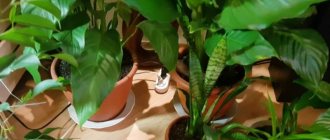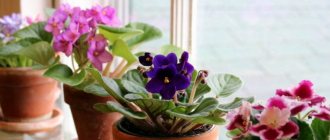The most important element of garden or apartment design are plants. Particularly impressive is the variety of plant species - from flowering shrubs to evergreen rock gardens and succulents that grow gracefully in alpine rockeries.
But plants with thorns deserve special attention. It would seem that the purpose of thorny plants is to repel insects and birds, but this is not so.
After all, with the help of thorny plants, a feeling of charm, unusualness and originality is created. In this article I will tell you which thorny plants can be planted in your garden or apartment. I will list the names of the most popular plants that will become a real decoration for any interior.
Euphorbia milli
This tropical succulent from the Euphorbiaceae family takes root well in city apartments. Its charming appearance is given by its flowering, which lasts all year round. The inflorescences themselves are inconspicuous, like most euphorbias, but the real decoration is the colorful, bracted leaves.
Due to its unpretentiousness, the plant does not require constant attention. The main thing in growing a flower is the formation of the crown. This is achieved by pruning the lower branches in early spring. Removing old branches will help maintain the optimal size of the plant and stimulate its flowering.
The danger of Euphorbia Milli lies in the toxicity of the flower. The milky sap of the plant contains caustic substances, contact with which causes poisoning or skin burns. And if it accidentally gets into the eyes, it causes temporary blindness.
Features and diseases
If your pet drops leaves, don't be alarmed. Thus, it forms a thick, thorny trunk. But when the leaves begin to turn yellow and fall off the top, take immediate action. This can occur either from drought or from excessive watering. Be guided by the condition of the soil.
In summer, feed the plant more often. In winter it goes into a dormant state. Reduce watering and fertilizing. Lack of sunlight may also be the cause of leaf fall. If there is not enough natural light, add artificial light.
Pachypodium also has disadvantages. It has poisonous juice. But the trunk is protected by thorns. A thorn prick will not cause any harm to health and may only cause minor irritation. After replanting or pruning the plant, wash your hands well. It is better to protect children from contact with thorns.
But these disadvantages outweigh the advantages of this unusual plant. The pachypodium will add uniqueness and specialness to the interior of your apartment.
Hibiscus
An incredibly beautiful tree-like shrub, growing up to 3 meters in height, has more than 200 species and varieties. The plant has lush foliage of a lush green hue. In the wild, hibiscus blooms with luxurious large buds resembling cups almost all year round, but at home flowering continues only from spring to autumn. But even without flowers, its decorative effect does not suffer - the tree looks impressive.
Like any tropical plant, hibiscus prefers bright light, high humidity and abundant watering. The only negative is the very slow growth of the plant. It will take more than one year for a young seedling to begin producing buds every year and delighting its owner.
Garden thorny plants
The main advantage of thorny plants is their unpretentiousness. This is what attracts the attention of many gardeners. Let's find out what types of plants with thorns can be used in the garden.
Carlina (stemless thornweed)
A very fancy exotic plant. It blooms in an unusual way, its inflorescences resemble large baskets (up to 12 cm in diameter) with a blue-lilac tint.
The flowers are hard and rough, giving the impression that they are made of thick cardboard. Karleena has an amazing property: at night and in cloudy weather, its flowers close, forming dense, large buds.
This flower is actively used to decorate the garden interior. Carlina's unusual inflorescences grow on long stems, so they can be combined with other, smaller flowers in flower beds.
Carlina is an undemanding plant. It tolerates both drought and heat well. The flower grows well in rocky places or on rocky slopes. In flower arrangements it goes well with alpine asters, juniper, wormwood and fescue.
Eringium (Eryngium)
An amazing thorny plant - eryngium. In recent years, it has been used by gardeners for decorative purposes and as an element that adds charm and personality to the garden.
Aeringium is a small shrub (about 70 cm in height) with numerous clusters of blue and bluish flowers.
Varieties of earingium:
- Earingium planifolia. The shrub reaches a height of 100 cm. The plant has small (compared to other varieties) inflorescences of a light blue or pale green hue.
- Eryngium vulgaris. A small shrub (up to 70 cm) with very numerous sharp spines. The plant blooms in small inflorescences with a dark blue or light blue tint.
- Variegated eryngium. Plant height is from 70 cm. The inflorescences are small, blue or purple.
Absolutely all eryngiums are used to decorate the landscape. These plants prefer to grow in rocky places and do not like heavy watering and sudden temperature changes. Eringium goes well in compositions with lavender, echinacea and juniper.
Milk thistle
Many gardeners consider thistle a weed. But this particular plant is very popular among landscape designers, because with its unusual appearance, thistle can transform the interior of any garden plot.
The pride of the spotted thistle is its unusual, large leaves. A white cobweb appears on the surface of the light green leaves. This combination creates a unique look. Please note, however, that thistle leaves are covered with sharp thorns, so this beautiful plant should not be touched.
The flowers are also very unusual. They are shaped like small baskets and range in color from crimson red to pale white. Like the leaves, the inflorescences have small, sharp spines along the edges.
Milk thistle is considered a medicinal plant. Herbalists use it in decoctions and tinctures for colds, coughs and diseases of the esophagus.
Tatarnik
A thorny plant with a threatening, frightening appearance. Tartar is a tall plant with a trunk up to 2 m long. Its leaves and inflorescences are its flowers. The leaves have a silvery tint.
The leaves are borne on stems that are thick and fleshy, giving the plant a Mars-like appearance. Calamus inflorescences are small “buds” of purple or red color.
With its spiky leaves, calamus can be used to decorate gardens. Ideal neighbors for thorny plants are dry elecampane, rudbeckia, conifers and other landscape flowers.
Thistle
Thistle is a popular plant in central Russia. It can also be grown in the garden. Its height is about 150 cm. Its main advantage is its flowering, which is very beautiful. The flowers are large, bright red or burgundy.
Thistle is a honey plant for bees. It can be planted in the garden to attract bees.
Dipsacus (tease)
Another amazing thorny plant that is impressive in the garden. Dipsacus grows up to 2 m in height and has strong stems with funnel-shaped leaves. Dipsacus blooms in large inflorescences, in which large, spiny flowers are formed towards the end of flowering.
This will be an advantage in the rock garden. Dipsacus blooms from mid-summer to late autumn. The plant goes perfectly with low-growing flowering shrubs.
Indoor rose
A miniature indoor rose bush in a cute pot is the dream of many plant growers. Colorful buds with a delicate scent and thin graceful shoots will not leave anyone indifferent. But this flower is known for its capricious and finicky disposition, so when breeding it you will have to be patient.
Caring for the plant is not easy. As in natural conditions, it must be sent to a cold room for wintering. And in the summer, indoor roses do not tolerate hot and dry weather well, so it is advisable to take the flower out into the open. It is important to avoid direct sunlight. The plant can simply burn out with prolonged exposure to ultraviolet radiation.
Growing from seeds
A good way to get several plants at once is to grow a succulent from seeds. In this case, you need to be patient. This is very painstaking work. The seeds will turn into an adult plant only after 4-5 years. But you'll be rewarded for your hard work when you grow a few of these exotic plants.
After purchasing the seeds, soak them for a couple of hours in a pink manganese solution. Plant in the prepared soil, pressing lightly on the seed with your finger. Moisten the soil and cover the container with glass or film. After the sprouts appear, open your greenhouse slightly to allow fresh air to enter.
Seedlings should be planted after two leaves appear on the stem. Try not to break the tender roots. Make the first transplant into small clay pots. It is better to take low and wide flower containers.
Philodendron
The perennial evergreen “guest” from the South American tropics is used for landscaping the window sills of apartments and office buildings. Philodendron is on the list of flowers that have a beneficial effect on the indoor microclimate. Substances with phytoncidal properties released into the air cleanse it of heavy impurities and harmful chemical elements.
The plant loves bright, diffused lighting, moderately moist soil, and a warm climate with a room temperature of +15...+25°C. It reacts negatively to dry air, so you should spray the flower with warm, settled water 2 times a week.
How to propagate milkweed?
To get “offspring” from an adult indoor plant, you can use three propagation options:
- By cuttings. The most popular propagation method uses stems or leaf cuttings of indoor milkweed. Be sure to wear gloves. It is necessary to cut off the upper part of the shoot, approximately 12 cm long. Dip it in warm water, this will stop the release of juice. After this, treat the cut area with charcoal and leave the plant until a film forms. At the next stage, the cuttings should be treated with “Kornevin” and planted in the ground, which consists of sand and peat. Be sure to water the cuttings and cover with film. It is important that the ambient temperature is at least 20°C. It will take several weeks for rooting.
- Seeds. First, seed stratification is carried out. To grow milkweed from seeds, you need to sow it in light soil to a depth of 2.5 cm. Cover the top with film and germinate at a temperature of 20-23°C. Shoots should appear after 2-3 months. It is important to regularly ventilate and keep the soil slightly moist. When 2-3 leaves appear, you can transplant them into a separate pot.
- Dividing by bushes. This option can only be used in early spring or autumn. You can make a different number of parts, the main thing is that there is at least one kidney. When the juice has drained, you need to sprinkle the cut area with wood corner. Place all parts in separate pots.
Araucaria indoors
An unusually beautiful heat-loving coniferous plant will create an atmosphere of freshness and peace in the house, returning the emotional state to a positive direction. This flower secretes special phytoncides that have high antimicrobial activity. This is very useful for frequent colds and problems with the respiratory system.
Araucaria grows in the shape of a regular pyramid, for which it received its second name - indoor spruce. The plant does not require any particularly difficult conditions. It is only necessary to maintain a temperature of +22°C in summer, and +15°C in winter. It is also important to regularly ventilate the room where araucaria grows. If possible, it is better to take it out into the fresh air.
Reproduction
As a rule, hatiora is propagated by stem cuttings consisting of 2-3 segments.
Important! The segments need to be broken off with your hands, as if twisting them, but not cut off.
Typically, cuttings are carried out in early spring, shortly after flowering ends. The place where the tear was made is sprinkled with crushed coal and dried in air for several hours. Subsequently, they are rooted in a peat-sand mixture, at a temperature from +20°C to +24ºC, in a small greenhouse, which is regularly ventilated.
Rooting occurs within a month. Then the cutting is transplanted into a small pot, gradually accustoming it to the air in the room. Often cuttings produce roots even in an ordinary glass of water.
Hatiora can be propagated by seeds, although this method is most often used by breeders. Seeds are sown in a moist substrate, constantly monitoring the temperature. Bottom heating is desirable. The germination rate of the seeds is low, and they sometimes take quite a long time to germinate.
Cryptomeria indoors
Cryptomeria indoors or Japanese cedar is a fragrant, compact-sized conifer that fits in the house and can easily replace a Christmas tree. This evergreen tree has a lush pyramid-shaped crown, and dark green needles with a bluish tint give it a decorative appeal. If you touch the needles with your hands, the air around you is immediately filled with a fresh pine aroma.
This tree is ideal for those gardeners whose home is always cool. Perhaps the only disadvantage of cryptomeria is intolerance to high temperatures. The maximum value on the thermometer should be no more than +12...+16°C at any time of the year. It is equally important to provide the indoor cedar with diffused lighting. Then the tree will retain its rich color and lush shape for a long time.
Differences with other representatives of cacti
Representatives of this family made up for the lack of moisture and nutrients in the dense Brazilian jungle by “climbing” trees or rocks growing nearby (in this case, the plants are called lithophytes) and adapting to life on them. Hatiora is often confused with rhipsalis. The main difference between them is the shades of the flowers and the forming segments. It is also believed that in rhipsalis they are flat, and in hatiora they are round.
According to various sources, there are from 7 to 10 plant species.
Kalanchoe laciniata
Due to its original appearance, Kalanchoe laciniata received the name “deer horns”. Its branched carved leaves of light green color are especially attractive to lovers of exotic plants.
This plant is a type of succulent that stores a record amount of water in its leaves and can go without watering for a long time. It will not cause problems during transplantation and propagation. Kalanchoe grows quickly and adapts well at home. Like any tropical guest, it loves bright lighting, so there will be no difficulties with placing a flower pot. You just need to exclude window sills on the north side.











